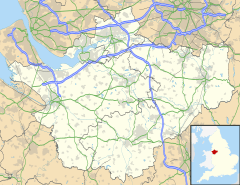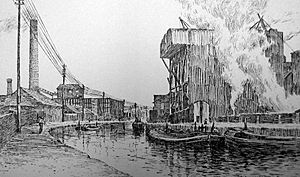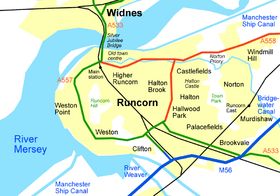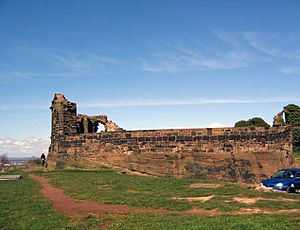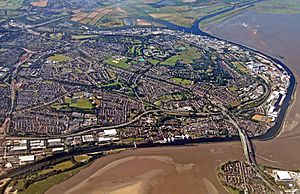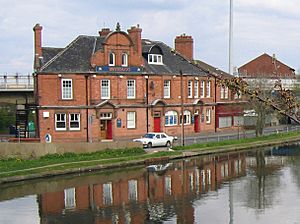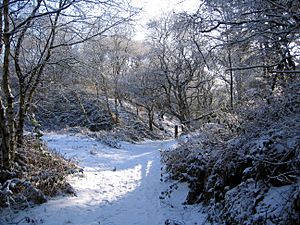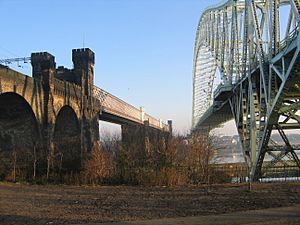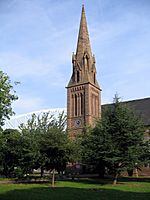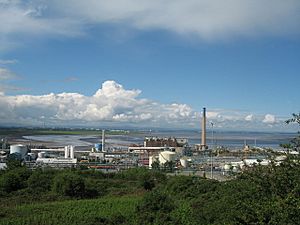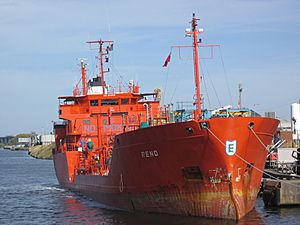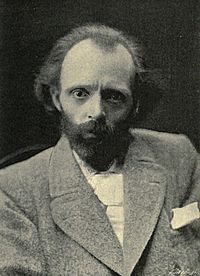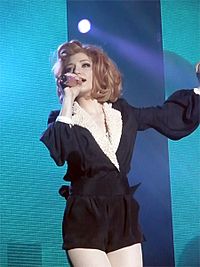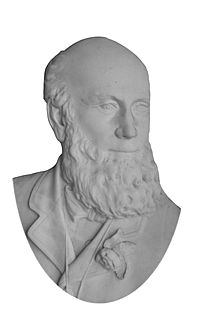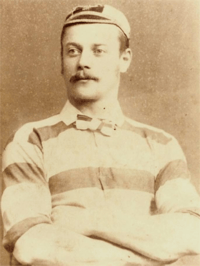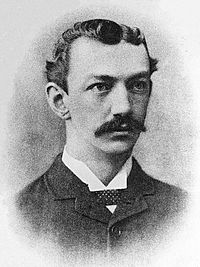Runcorn facts for kids
Quick facts for kids Runcorn |
|
|---|---|
| Town | |
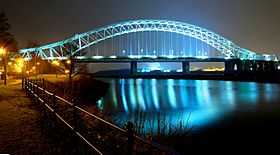 Runcorn's Silver Jubilee Bridge |
|
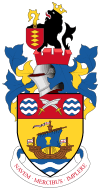 Coat of arms |
|
| Population | 61,789 (2011) |
| Demonym | Runcornian |
| OS grid reference | SJ525815 |
| • London | 167 mi (269 km) SE |
| Unitary authority | |
| Ceremonial county | |
| Region | |
| Country | England |
| Sovereign state | United Kingdom |
| Post town | RUNCORN |
| Postcode district | WA7 |
| Dialling code | 01928 |
| Police | Cheshire |
| Fire | Cheshire |
| Ambulance | North West |
| EU Parliament | North West England |
| UK Parliament |
|
Runcorn is an industrial town and cargo port in the Borough of Halton in Cheshire, England. Its population in 2011 was 61,789. The town is in the southeast of the Liverpool City Region, with Liverpool 11 mi (18 km) to the northwest across the River Mersey. Runcorn is on the southern bank of the River Mersey, where the estuary narrows to form the Runcorn Gap.
Runcorn was founded by Ethelfleda in 915 AD as a fortification to guard against Viking invasion at a narrowing of the River Mersey. Under Norman rule, Runcorn fell under the Barony of Halton and an Augustinian abbey was established here in 1115. It remained a small, isolated settlement until the Industrial Revolution when the extension of the Bridgewater Canal to Runcorn in 1776 established it as a port which would link Liverpool with inland Manchester and Staffordshire. The docks enabled the growth of industry, initially shipwrights and sandstone quarries. In the late 18th and early 19th centuries, it was a spa and health resort but this ended with the growth of polluting industries, especially soap and chemical works. In 1964, Runcorn was designated a new town and expanded eastward, swallowing neighbouring settlements and more than doubling its population.
Three bridges span the River Mersey and the Manchester Ship Canal at Runcorn: the Silver Jubilee Bridge, Mersey Gateway, and Runcorn Railway Bridge. Its location between Liverpool and Manchester and its links to the rail, motorway and canal networks have made it a centre for manufacturing, logistics, and wholesale and retail. The town's motto is Navem Mercibus Implere (Latin for "fill the ship with goods"), a classical quotation from Juvenal.
Contents
History
The earliest written reference to the town is in the Anglo-Saxon Chronicle, where it is spelled "Rumcofan", literally meaning "a wide cove or bay". This word is derived from the Old English words "rúm" ("wide" or "broad") and "cofa" ("cave" or "cove"). Other historical spellings of Runcorn include "Rumcoven", "Ronchestorn", "Runckhorne", and "Runcorne".
Little is known about the early history of the settlement but isolated findings of objects from the Stone, Bronze, and Iron Ages have been made and there is evidence of a Roman presence in the area. The earliest recorded event in its history is the building by Ethelfleda of a fortification at Runcorn to protect the northern frontier of her kingdom of Mercia against the Vikings in 915. The fort was built on Castle Rock overlooking the River Mersey at Runcorn Gap.
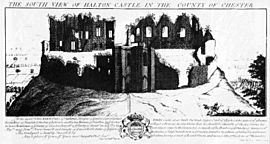
Following the Norman conquest, Runcorn was not mentioned in the 1086 Domesday survey, although surrounding settlements were. William the Conqueror granted the earldom of Chester to Hugh d'Avranches who granted the barony of Halton to Nigel. It is likely that Nigel erected a motte and bailey castle on Halton Hill in the 1070s. In 1115, Nigel's son, William Fitznigel, founded an Augustinian Priory at Runcorn. In 1134 the priory was moved to Norton, about 3.5 miles (6 km) away. In 1391 the priory was raised to the higher status of abbey. In 1536 the monastery was dissolved, and around nine years later the buildings and some of the monastic lands were sold to Sir Richard Brooke who converted the habitable part of the abbey into a house.
During the Civil War Halton Castle was held for the Royalists by John Savage, 2nd Earl Rivers, the Steward of Halton. It fell twice to Parliamentarian Roundheads. The first siege was led by Sir William Brereton in 1643; the second was during the following year. Following this, a "Council of War" was held in Warrington in 1646 at which it was decided that the castle should be slighted. In 1656, Runcorn was described as being "nothing but a fair parish church, a parsonage and a few scattered tenements". And so it remained for over a century, an isolated and poor hamlet. The only through traffic used the ferry which crossed from Runcorn to the north bank of the River Mersey. Towards the end of the 18th century and in the early years of the 19th century the town was a health resort.
| Year | 1901 | 1911 | 1921 | 1931 | 1941 | 1951 | 1961 | ||||||
|---|---|---|---|---|---|---|---|---|---|---|---|---|---|
| Population | 16,491 | 17,353 | 18,476 | 18,127 | 21,718 | 23,931 | 26,035 | ||||||
| Source: | |||||||||||||
During the 18th century water transport had been improved in the area by the Mersey and Irwell Navigation, the Bridgewater Canal and the Trent and Mersey Canal. This gave Runcorn waterway connections with most of the interior of England through the canal system and with the sea along the River Mersey, thus forming the basis for the development of the Port of Runcorn. Later came the Runcorn to Latchford Canal linking with the Mersey and Irwell Navigation, and the Weston Canal which gave better access to the Weaver Navigation system. Industries began to develop within and around the town, in particular quarrying for Runcorn sandstone, shipbuilding, engineering, the manufacture of soap and chemicals and tanning. Runcorn was becoming an industrialised and highly polluted town. During the later 19th century the town became increasingly dominated by the chemical and tanning industries.
In 1868 the Runcorn Railway Bridge was opened across the Mersey, giving Runcorn direct rail links with Liverpool and the rest of the country. In the 1880s a pipeline was opened between Northwich and Weston Point, supplying brine to the salt and chemical works. In 1894 the Manchester Ship Canal was opened throughout its length. This allowed ocean-going ships to travel inland as far as Salford, some of them calling at the port of Runcorn. The rise in population between 1881 and 1891 and the drop by 1901 is explained by the number of people involved in constructing the ship canal. In 1905 the Widnes-Runcorn Transporter Bridge opened, giving a direct link for vehicular traffic for the first time between the two towns.
During the first half of the 20th century the industry of the town continued to be dominated by chemicals and tanning. This growth was largely due to government fixed-priced cost contracts for tanned hides. In 1926 four chemical companies merged to form Imperial Chemical Industries (ICI). As the century progressed there was a diversification of industry. In 1961 the Transporter Bridge was replaced by Runcorn Road Bridge (since named the Silver Jubilee Bridge) which allowed a more efficient means of road traffic across Runcorn Gap. The designation of Runcorn as a new town in 1964 brought major changes and more than doubled the population. Much of the architecture of the new town was innovative, especially the Southgate development designed by Sir James Stirling and built between 1970 and 1977. Stirling's housing development was beset with problems and it was demolished in the early 1990s. During the second half of the 20th century the tanneries closed (the last to close was the Highfield Tannery in the late 1960s) and the chemical industry declined. At the same time, light industry developed together with warehouses and distribution centres.
Geography
Runcorn is situated on a spur projecting into the River Mersey, which flows to the north and then to the west of the town. On the north bank of the river is another spur forming the West Bank area of Widnes; together these form Runcorn Gap, a narrowing of the River Mersey. Runcorn Gap is crossed by the Runcorn Railway Bridge, which carries the Liverpool branch of the West Coast Main Line, and the Silver Jubilee Bridge, which carries the A533. To the south of the town is the River Weaver and the Weston Canal. Both open into the ship canal. To the southeast of the town run the M56 motorway, the Chester–Manchester railway line, and the main branch of the West Coast Main Line. The town has a system of "expressways", roads designed to divert traffic away from the residential areas. The Central Expressway runs through the centre of the town in a north-south direction. To the west of it lie most of the former settlements which formed the older part of the town, namely Runcorn, Higher Runcorn, Weston, Weston Point and Clifton (formerly Rocksavage), and the new town areas of Halton Brook and Halton Lodge. To the east are the village of Halton, the old settlements of Norton and Stockham, and the new town areas of Castlefields, Palacefields, Windmill Hill, Murdishaw, Brookvale and Hallwood Park.
The density of housing is generally high, but there are open green areas, in particular heathland on Runcorn Hill and the extensive Town Park created as part of the new town. The older industries, particularly the remaining chemical factories, are concentrated mainly to the southwest of the town bordering the Mersey, while newer industries, including warehousing, are to the northeast and southeast.
Geology
The Runcorn area drains into the River Mersey to the north and the River Weaver to the south. The bedrock of the western and northeastern parts of the town is made up of rock from the Sherwood sandstone group; in the other areas the bedrock is from the Mercia mudstone group. In places there are prominent outcrops of sandstone, particularly at Runcorn Hill and Halton Hill. Elsewhere the bedrock is covered by drift. At the northwestern periphery of the town the drift consists of recently blown sand. Farther to the east and bordering the River Mersey is recent alluvium. Elsewhere the drift consists of till.
Climate
Being close to the west coast and the Irish Sea, the climate is generally temperate. The mean average temperature in the years 1971 to 2000 was 9.4 to 9.7 °C, which was slightly above the average for the United Kingdom as was the average amount of annual sunshine at 1,391 to 1,470 hours. The average annual rainfall was 741 to 870 mm, which was slightly below the average for the UK. The average number of days in the year when snow is on the ground is 0 to 6, which is low for the United Kingdom. The average number of days of air frost is 2 to 39, which is also low.
Demography
Population growth
Early census statistics for the town include only the areas known now as the Old Town and Higher Runcorn. In the early twentieth century, Runcorn Urban District grew to incorporate the neighbouring villages of Weston and Halton. The present statistical boundaries of Runcorn were defined in the Runcorn New Town (Designation) Order 1964 which greatly expanded the town to the east.
The population of Runcorn in 1664 has been estimated as 305.
| Year | Population | Change as % |
|---|---|---|
| 1801 | 1,379 | — |
| 1811 | 2,060 | +49.4% |
| 1821 | 3,103 | +50.6% |
| 1831 | 5,035 | +62.3% |
| 1841 | 6,951 | +38.1% |
| 1851 | 8,688 | +25.0% |
| 1861 | 10,063 | +15.8% |
| 1871 | 12,066 | +19.9% |
| 1881 | 15,126 | +25.4% |
| 1891 | 20,020 | +32.4% |
| 1901 | 16,491 | −17.6% |
| 1911 | 17,353 | +5.2% |
| 1921 | 18,476 | +6.5% |
| 1931 | 18,127 | −1.9% |
| 1939 | 21,718 | +19.8% |
| 1951 | 23,931 | +10.2% |
| 1961 | 26,035 | +8.8% |
| 1971 | 35,999 | +38.3% |
| 1981 | 64,196 | +78.3% |
| 1991 | 64,952 | +1.2% |
| 2001 | 60,320 | −7.1% |
| 2011 | 61,789 | +2.4% |
Religion
The 2011 census showed that 70.1% of people living in Runcorn declared themselves to be Christian, significantly higher than the national average in England of 59.4%. 23.5% stated that they had "no religion" and 5.5% made no religious claims. Those stating their religions as Buddhist, Hindu, Jewish, Islam, or Sikh amounted to 0.8%.
The town's Anglican churches are part of the Diocese of Chester and the Deanery of Frodsham. The parish church is All Saints Church, and there are 10 other Anglican churches in the town. Five Catholic churches can be found in Runcorn and are administered by the Diocese of Shrewsbury.
There are two Methodist chapels and several shared churches. Wicksten Drive Christian Centre is shared between Anglicans and Methodists. Hallwood Ecumenical Parish in Beechwood and Palace Fields consists of 2 churches, both recognised by the Church of England, the Methodist Church and the United Reformed Church. There is also a Pentecostal church, two independent evangelical churches, a Church of Jesus Christ of Latter-day Saints chapel, a spiritualist church, and a Jehovah's Witnesses Kingdom Hall.
In 2013, the former Waterloo Hotel was converted into a Buddhist temple by Wat Phra Singh. As of May 2014[update], there are five resident monks.
Ethnicity
In the 2011 census, of Runcorn's 61,789 residents, 97.8% were White, with 96.3% identifying as White British. Mixed/multiple ethnic groups made up 1.2%, Asian/Asian British 0.7%, Black/African/Caribbean/Black British 0.2%, and Other/Arab 0.1%. 98.5% had English as a first language.
Landmarks and places of interest
The major landmark in the town is Halton Castle on the top of Halton Hill near the geographical centre of the town. Only ruins of the castle exist, but there are widespread views from the top of the hill. The castle grounds are open at advertised times. Incorporated in the castle walls is the Castle Hotel building, which used to include a courthouse on the first floor. Another landmark is Norton water tower, built of Runcorn sandstone, 112 feet (34 m) high, which holds 672,000 imperial gallons (3 million litres) of water and supplies it to Liverpool.
An important historical site and the major visitor centre in the town is Norton Priory, now a museum. The site contains the remains of a priory with adjacent gardens, formerly of a country house. Nearby are a walled garden, including a national collection of tree quinces, and an ice house.
Much of the architecture of the town is undistinguished, but there are listed buildings of some importance. The listed churches are All Saints Parish Church and Holy Trinity Church in the centre of the older part of the town, St Mary's in Halton village, St John's in Weston, and Christ Church in Weston Point. All Saints' Church, a Grade II* listed building, dates from 1849 and was built by Anthony Salvin in red sandstone. The oldest existing houses are the Seneschal's House in Halton village (1598), Weston Old Hall (1607), Brookfield Farmhouse (1691) and Halton Old Hall (1693). Other outstanding houses include Runcorn Town Hall (formerly Halton Grange), Camden House and Cottage in High Street and Bridgewater House near the ship canal.
A war memorial to those who lost their lives in the First and Second World Wars, as well as those killed in later conflicts, is located at the end of Moughland Lane. There is a memorial in Castle Road, Halton village, commemorating residents of the village who served in the Boer War.
Culture
Theatre and cinema
The Brindley is a theatre and arts centre which opened in 2004. It is situated in the old town centre and named after James Brindley, engineer of the adjacent Bridgewater Canal. It contains a proscenium theatre seating 420 and a multi-purpose theatre seating 108, The Studio, which doubles as a cinema. There is an exhibition space for art installations, a small café and multi-purpose rooms. The centre is owned and administered by Halton Borough Council which runs community events in the building. In 2007, it won the title of "Best Arts Project in the UK" at the National Lottery Awards. A multiplex cinema run by Cineworld is in Trident Park.
Filmography
Runcorn has been used for the shooting of films and television programmes. Some of the sequences in the first two series of the BBC police drama Merseybeat were filmed in and around the town. The BBC situation comedy Two Pints of Lager and a Packet of Crisps was set in Runcorn. External shots of the Waterloo Hotel in the area of High Street known as Top Locks (which is known in the show as The Archer) appear as well. The opening credits show the Silver Jubilee Bridge and Halton Castle. Drop Dead Gorgeous, a drama on BBC Three, was set in Runcorn. Norton Priory has been used as a location in films and television programmes. Areas of Runcorn old town have featured in The Five TV crime drama series on Sky1.
Media
Runcorn is served by two weekly papers, the Runcorn Weekly News and the Runcorn World. The town is also home to Halton Community Radio, which broadcasts over the Runcorn and Widnes area on the frequency 92.3FM. This is a non-commercial radio station which is run by volunteers. HCR was launched on 8 August 2008, and currently has a five-year licence to broadcast.
The Runcorn Ferry
Before the building of Runcorn Railway Bridge and its attached footbridge, the only way to cross the Mersey at or near Runcorn Gap, other than by the dangerous method of fording, was by ferry. The ferry has a history going back to the 12th century. The ferry was celebrated in the monologue entitled The Runcorn Ferry, written by Marriott Edgar and popularised by Stanley Holloway. It includes the lines:
Per tuppence per person per trip ...
Per trip or per part of per trip.
Community facilities
The main library is at Halton Lea with a branch library in the old town centre. Runcorn has two locations offering One-Stop-Shop facilities; one is Halton Direct Link in Halton Lea, and the other is in the old town library. Runcorn Direct Link also includes a Tourist Information Centre.
Runcorn Hill Local Nature Reserve has been developed on the site of a quarry and consists of heathland. Adjacent to it is a park which includes a bandstand, a model boating lake and sports facilities. Wigg Island is a nature reserve on a former industrial site. The reserve is on an island between the Manchester Ship Canal and the River Mersey and consists of open spaces and woodland with bird hides and pathways. Other nature reserves in the town are Murdishaw Valley, Oxmoor Woods and Ponds, and Dorchester Park. Further public open areas are Rock Park, Town Hall Park and Phoenix Park. Open areas in Runcorn form part of Mersey Forest, one of Britain's community forests.
Runcorn's hospital is Halton General Hospital, which is administered by the Warrington and Halton Hospitals NHS Foundation Trust. Originally planned as a District General Hospital, it was never large enough to provide a full range of services. Acute medical services have been transferred to Warrington Hospital and Halton General has become a centre for non-emergency surgery and rehabilitation. Although it never had its own accident and emergency department the hospital has a minor injuries unit for basic emergency care. On the same site is the Cheshire and Merseyside NHS Treatment Centre, a purpose-built hospital for orthopaedic surgery. Halton Haven Hospice is in the Murdishaw area of the town. The body responsible for planning health services in Runcorn, including primary care, is the Halton Clinical Commissioning Group.
Transport
The Runcorn New Town Masterplan created three distinct types of road: busways, expressways and local roads. In addition, there is a network of dedicated cycleways in the town.
The Runcorn Busway was the world's first bus rapid transit system in 1971. First conceived in the Runcorn New Town Masterplan in 1966, it opened for services in October 1971 and all 22 km (14 mi) were operational by 1980. It is a road network for use by buses only and, unlike guided busways or bus lanes, it is a totally separate road system, not running alongside (or down the middle of) existing roads. It was designed so that most residents would be no more than five minutes walking distance, or 500 yd (457.2 m), from a bus stop. The central station is at Runcorn Shopping City where buses arrive on dedicated raised busways to two enclosed stations. Professor Arthur Ling, Runcorn Development Corporation's Master Planner, claimed to have invented the concept while sketching on the back of an envelope. Bus services are provided by Arriva North West, Anthony's Travel, MP Travel, Warrington's Own Buses, Ashcroft Travel, Halton Community Transport and Stagecoach. Two coach companies operate from the town; Selwyns Travel, and Anthony's Travel.
The expressways form a ring road around the town in a figure of eight and are intended to keep all through traffic off the local roads. This system links north to Widnes and Liverpool by the A533 over the Mersey Gateway bridge, east to Warrington by the A56, south to Northwich and north Cheshire by the A533, and west by the A557 to the M56 and to Frodsham. The M56 links to the M6 and, to the north of Widnes, the A557 links to the M62.
There are two railway stations. Runcorn, located in the old town, is on the Liverpool branch of the West Coast Main Line, and is managed by Avanti West Coast, which provides services between Liverpool Lime Street and London Euston. West Midlands Trains run a service between Liverpool and Birmingham New Street that calls at the station. Runcorn East station, located in the Murdishaw district of the new town, is managed by Transport for Wales, and provides services to Warrington, Manchester, Chester and North Wales.
Runcorn is 8 mi (13 km) from Liverpool John Lennon Airport and 22 mi (35 km) from Manchester Airport.
Religion
The 2001 census showed, that of the people living in the borough of Halton, 83.8% declared themselves to be Christian, 8.7% stated that they had "no religion," and 7.0% made no religious claims at all. Those stating their religions as Buddhist, Hindu, Jewish, Islam or Sikh amounted to 0.5%.
The Anglican churches are part of the Diocese of Chester and the deanery of Frodsham. In Runcorn, the parish church is All Saints in the old town centre. Ten other Anglican churches are in the town. Five Roman Catholic churches can be found in Runcorn and are administered by the Diocese of Shrewsbury. There are three Methodist chapels and one Welsh Presbyterian chapel. Wicksten Drive Christian Centre is shared between the Church of England and the Methodists. Hallwood Ecumenical Parish in Beechwood and Palace Fields consists of 3 churches all recognised by the Church of England, the Methodists and the United Reformed Church. Norton Ecumenical Parish, covering Windmill Hill, Norton and Murdishaw, is served by an Ecumenical Partnership between St Berteline's Church (Anglican) and Murdishaw Ecumenical Church (Methodist run).
There is an Independent Baptist chapel, three independent Christian churches, and a LDS Church. The Jehovah's Witnesses have two Kingdom Halls with three congregations, and there is a Spiritualist church. In 2013 the former Waterloo Hotel was converted into a Buddhist temple by Wat Phra Singh UK. As of May 2014[update], there are five resident monks.
Economy
Runcorn has a higher proportion of people working in manufacturing, logistics, and wholesale and retail than the average for England. Chemical manufacturing has been the town's dominant sector since the 19th century, but the local economy has increasingly diversified into other advanced manufacturing sectors, such as aerospace and automotive, as well as services and logistics.
The main industrial areas of the town are Astmoor, Manor Park, Whitehouse, the Heath and Weston Point. Sci-Tech Daresbury is to the southeast of the town. The main retail and leisure area is Shopping City in the centre of the town with a smaller district centre at the old town.
| Industry | Runcorn (Resident Jobs) | Runcorn (%) | Halton (%) | England (%) | Runcorn – England Difference |
|---|---|---|---|---|---|
| C Manufacturing | 3,829 | 13.7 | 12.5 | 8.8 | 4.9 |
| H Transport and storage | 2,087 | 7.4 | 6.9 | 5.0 | 2.4 |
| G Wholesale and retail trade; repair of motor vehicles and motor cycles | 5,069 | 18.1 | 18.7 | 15.9 | 2.2 |
| N Administrative and support service activities | 1,579 | 5.6 | 5.3 | 4.9 | 0.7 |
| E Water supply; sewerage, waste management and remediation activities | 334 | 1.2 | 1.6 | 0.7 | 0.5 |
| J Information and communication | 1,247 | 4.4 | 3.9 | 4.1 | 0.3 |
| O Public administration and defence; compulsory social security | 1,721 | 6.1 | 6.5 | 5.9 | 0.2 |
| D Electricity, gas, steam and air conditioning supply | 194 | 0.7 | 0.8 | 0.6 | 0.1 |
| Q Human health and social work activities | 3,460 | 12.3 | 12.0 | 12.4 | −0.1 |
| B Mining and quarrying | 40 | 0.1 | 0.2 | 0.2 | −0.1 |
| L Real estate activities | 314 | 1.1 | 1.2 | 1.5 | −0.4 |
| I Accommodation and food service activities | 1,388 | 5.0 | 4.6 | 5.6 | −0.6 |
| A Agriculture, forestry and fishing | 44 | 0.2 | 0.2 | 0.8 | −0.6 |
| F Construction | 1,881 | 6.7 | 7.4 | 7.7 | −1.0 |
| R, S, T, U Other | 988 | 3.5 | 3.8 | 5.0 | −1.5 |
| M Professional, scientific and technical activities | 1,305 | 4.7 | 4.5 | 6.7 | −2.0 |
| K Financial and insurance activities | 555 | 2.0 | 2.4 | 4.4 | −2.4 |
| P Education | 1,993 | 7.1 | 7.7 | 9.9 | −2.8 |
Manufacturing and chemicals
The town's chemical industry was dominated for many years by ICI's Chlor Chemical division. But since 2001, Inovyn (a wholly owned subsidiary of Ineos) has operated the extensive chemical works in the west of the town, employing 750 people in 2020. In Runcorn, Invoyn manufactures chlorine, caustic soda and chlorinated derivatives. It also produces salt, made from brine transported by pipeline from the saltfields of central Cheshire, and sulphuric acid. Several other chemical manufacturers also have a presence at the site, including Koura (formerly Mexichem Fluor), Industrial Chemicals, Packed Chlorine Limited, VYNOVA and Runcorn MCP Ltd (a joint venture between INOVYN and VYNOVA). The site is considered to be of strategic national importance to the UK. The site includes two independently owned power stations; the 810 MW natural gas fired Rocksavage Power Station and the Runcorn Energy Recovery Facility operated by Viridor which also supplies heat to the Inovyn facility. ICI's other former site in Runcorn comprising offices and laboratories is now the Heath Business and Technical Park, which provides office, laboratory, conference, and leisure facilities.
Other large employers include advanced manufacturing firms Sigmatex (manufacturer of carbon fibre), Héroux-Devtek (manufacturer of aircraft landing gear), Whitford (manufacturer of speciality coatings), Teva (manufacturer of pharmaceuticals) and Fresenius Kabi (manufacturer of medical and pharmaceutical products). Drinks manufacturer, Diageo, has maintained a packaging plant at Runcorn since 1970 which packages Guinness, Pimm's, Kilkenny and Smirnoff Ice for distribution in Great Britain.
Sci-Tech Daresbury is a National Science and Innovation Campus to the south east of Runcorn. The campus offers lab space, offices and workshops to rent. It is home to the largest supercomputer in Europe and the Virtual Engineering Centre which works with Bentley motor cars, BAE Systems and Jaguar Land Rover. The site also houses Daresbury Laboratory which employs over 300 staff specialising in accelerator science, bio-medicine, physics, chemistry, materials, engineering and computational science.
Logistics
Runcorn's position between Liverpool and Manchester airports and its links to the rail, motorway and canal networks have made it a centre for logistics. There are two ports in the west of the town on the Manchester Ship Canal. Runcorn Docks is owned by the Manchester Ship Canal Company, which is part of the Peel Ports Group. Weston Point Docks is operated by FLX Logistics.
There are several large logistics depots across Runcorn, including Eddie Stobart Group's road haulage site and driver training school in Manor Park, the Downton haulage depot at the Whitehouse Industrial Estate, and an NHS Supply Chain Depot in Astmoor Industrial Estate.
Services
There has been a shift in employment from manufacturing to service industries. In 1991, 34% worked in the manufacturing sector and 61% were in the service sector. By 2004, 17% were in manufacturing jobs and 78% were in service jobs. This trend in the local region is demonstrated in this chart which shows the regional "gross value added" of Halton and Warrington at current basic prices, with figures in millions of pounds.
| Year | Regional Gross Value Added | Agriculture | Industry | Services |
|---|---|---|---|---|
| 1995 | 3,636 | 14 | 1,361 | 2,261 |
| 2000 | 4,768 | 10 | 1,433 | 3,324 |
| 2003 | 5,774 | 18 | 1,399 | 4,356 |
- includes hunting and forestry
- includes energy and construction
- includes financial intermediation services indirectly measured
- Components may not sum to totals due to rounding
Runcorn has two shopping centres. The original shopping area was in the older part of the town on High Street, Regent Street and Church Street. This centre continues to exist, but with the coming of the new town, has declined. In the centre of the new town, Runcorn Shopping City is an enclosed shopping mall with two attached bus stations. Adjacent to it is Trident Retail Park containing shopping outlets and a cinema and nearby is a large Asda superstore that opened in 1989.
Sports
Football
The town has two senior football teams – Runcorn Linnets FC and Runcorn Town FC. It also has a Sunday League and a Junior League. There is an open age women's team, Runcorn Ladies FC, which is affiliated to Liverpool FA and plays in the Liverpool County Women's Open Age Division.
Runcorn Linnets were formed as a trust-based team in 2006 from the now defunct Runcorn F.C. Halton. It has existed in various guises since 1918, and its performance peaked in 1982 when it won the Alliance Premier League, then the highest division below the Football League.
Runcorn Town was formed in 1970 as Mond Rangers FC with the club changing their name in 2005 in order to "try and bring a more professional look to the club in general, and increase support from both businesses and individuals in the local community." After finishing in third place in the West Cheshire League at the end of the 2009/10 season, the club were elected to join the North West Counties League at their AGM, the highest level that they have ever played at.
Rugby
In the late 19th century, and prior to the 1895 schism, rugby union was played at the now defunct Runcorn RFC. When the rugby football schism occurred in 1895, Runcorn became founder members of the Northern Rugby Football Union (now Rugby Football League). Runcorn finished bottom of the league in the 1914–15 season and did not recommence playing in the aftermath of the First World War.
Rugby league in the town is now represented by Runcorn RLC.
Other sports
Runcorn Sports Club in Higher Runcorn hosts several clubs, including Runcorn Cricket Club, Hockey Club, Running Club and Subscription Bowling Club.
Runcorn Rowing Club is sited on the River Weaver Navigation near Clifton Village and also houses Runcorn Canoe Club.
Weston Angling Club Runcorn is a private fishing club which owns Sandymoor Pool in the east of the town.
There is an 18-hole golf course at Runcorn Golf Club in Clifton Road. Nearby is Heath Tennis Club which uses facilities at the Heath School.
Runcorn Ski Centre in Town Park consists of three dry ski slopes: an 85-metre main slope, a 45-metre extended nursery slope, and a 25-metre nursery slope. The centre runs both skiing and snowboarding lessons.
Runcorn had a professional wrestling school and promotion called the Runcorn Wrestling Academy (RWA) from 2005 until 2020, when it closed.
Notable people
Arts and entertainment
- Elizabeth Jocelin (1595–1622), writer
- Francis William Bourdillon (1852–1921), poet, translator, bibliophile, and scholar
- Sir Hall Caine CH KBE (1853–1931), novelist, dramatist, short story writer, poet and critic. World War I allied propagandist. Awarded Order of Leopold (Belgium).
- Alistair Taylor (1935–2004) assistant to Brian Epstein and General Manager of Apple Corps
- Anna Keaveney (1949–2004), actress
- Martin Roscoe (born 1952), classical pianist
- John Bishop (born 1966), comedian, presenter, and actor
- Phil Collins (born 1970), artist
- Pete Edmunds (born c. 1972), actor, voice actor, photographer, and artist
- Kym Marsh (born 1976), singer and actress
- Raymond Waring (born 1977), actor
- Susan Nickson (born 1982), television writer and producer
- Nicola Roberts (born 1985), singer and member of girl band Girls Aloud
Public service
- The Barony of Halton (1071–1413) comprised a succession of 15 barons; the seat of the Barons of Halton was Halton Castle
- Richard Brooke (died 1569), bought the manor of Norton from Henry VIII in 1545
- John Savage, 2nd Earl Rivers (c. 1603–1654), politician and royalist
- Sir Henry Brooke, 1st Baronet (1611–1664), soldier and politician
- Sir John Chesshyre (1662–1738), lawyer
- Nathan Alcock (1707–1779), physician
- Thomas Alcock (1709–1798), Vicar of Runcorn, writer, cider maker
- Thomas Hazlehurst (1816–1876), Methodist who paid for the construction of 12 chapels and three schools in the area
- Sir John Rigby PC (1834–1903), judge, politician, and MP for Wisbech
- William Allen Whitworth (1840–1905), mathematician and priest in the Church of England
- Thomas Alfred Jones VC, DCM (1880–1956), awarded the Victoria Cross and Distinguished Conduct Medal during World War I
- Wilson Baker FRS (1900–2002), organic chemist
- John Riley Holt FRS (1918–2009), Professor of Experimental Physics at Liverpool University, helped develop the atom bomb
Sports
- Harry Speakman (1864–1915), rugby player
- Samuel Houghton (1870–1920), rugby player
- Jack Fish (1880–1940), rugby player
- Dick Padbury (1886–unknown), rugby player
- Ernie Shaw (1894–unknown) rugby player
- Robert Done (1904–1982), footballer
- Bridget Duke-Wooley (1915–1976), alpine skier, competed in the 1948 Winter Olympics
- Ray Dutton (born 1945), rugby player
- Graham Abel (born 1960), footballer
- Robin Reid (born 1971), boxer
- Kieron Durkan (1973–2018), footballer
- Mike Jackson (born 1973), footballer
- Kenny Lunt (born 1979), footballer
- Lorna Webb (born 1983), professional cyclist
- Scott Brown (born 1985), footballer
- Jimmy McNulty (born 1985), footballer
- Shauna Coxsey MBE (born 1993), professional rock climber
Business and industry
- Thomas Hazlehurst (1779–1842), founder of soap and alkali manufacturer Hazlehurst & Sons
- Charles Wigg (1824–1899), manufacturer of chemicals at Wigg Works, which later became Wigg Island
- Hamilton Castner (1858–1899), American industrial chemist, formed the Castner-Kellner Alkali Company in Runcorn, which operates the Castner–Kellner process
- Sir William Edward Dudley (1868–1938), president of the Co-operative Wholesale Society
Images for kids
See also
 In Spanish: Runcorn para niños
In Spanish: Runcorn para niños


